SWEDISH SOUTH ASIAN STUDIES NETWORK
Department of Religious Studies and Theology, Faculty of Arts and Education, Karlstad University:
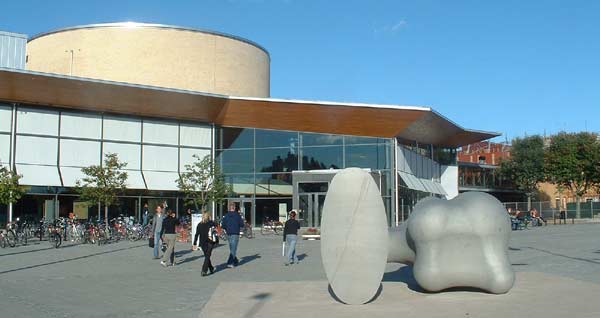 Postal adress: Religionsvetenskap/Estetisk-filosofisk
fakultet, Karlstad University, SE-651 88 Karlstad, Sweden
Postal adress: Religionsvetenskap/Estetisk-filosofisk
fakultet, Karlstad University, SE-651 88 Karlstad, Sweden
Visiting address: Universitetsgatan 1
Fax: +46 54-700 14 98
Web site: http://www.sam.kau.se/religion/
Contact persons:
Professor Kjell Härenstam,
ph: +46 54-700 13 02.
Personal
web page.
Asst. Professor Marc Katz, ph: +46
54-700 12 93
Ongoing research connected to South Asia:
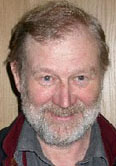 •
Professor Kjell Härenstam is
engaged in studies of religion in North India. His field of studies concerns
the didactics of religion, especially Tibetan Buddhism. By bringing students
to India, to Varanasi and Dharamsala, and discussing their experiences
Kjell also gets a direct feedback into his research. He has been connected
to Karlstad University since 1974 and has, along with colleagues, been
instrumental in creating a teaching and research centre emphasising World
religions besides Christianity, such as Islam and Buddhism. He defended
his doctoral dissertation in 1993 on an analysis of how Islam is portrayed
in Swedish school books, ”Textbook
Islam: An analysis of the image of Islam in Religious Education Textbooks”
(Acta Universitatis Gothoburgensis).
•
Professor Kjell Härenstam is
engaged in studies of religion in North India. His field of studies concerns
the didactics of religion, especially Tibetan Buddhism. By bringing students
to India, to Varanasi and Dharamsala, and discussing their experiences
Kjell also gets a direct feedback into his research. He has been connected
to Karlstad University since 1974 and has, along with colleagues, been
instrumental in creating a teaching and research centre emphasising World
religions besides Christianity, such as Islam and Buddhism. He defended
his doctoral dissertation in 1993 on an analysis of how Islam is portrayed
in Swedish school books, ”Textbook
Islam: An analysis of the image of Islam in Religious Education Textbooks”
(Acta Universitatis Gothoburgensis).
Kjell Härenstam has continued to study the issue of didactics of
religion and intercultural learning in an International context, and is
a member of EAWRE (European Association for World Religions in Education).
In 1996 he participated in the German anthology ”Dialog der
Religionen im Unterricht. Theoretische und praktische Beiträge zu
einem Bildungsziel” with a text on ”Thematische Studien
zu den Weltreligionen in der Ausbildung von Lehrern und Lehrerinnen”,
and has in recent years been involved in an International initiative on
implementing helpdesks for intercultural learning materials in Europe.
Kjell Härenstam was a member of SASNET’s board during the period
2004-06.
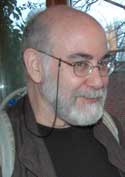 Marc
Katz, is engaged in research in the eastern part of Uttar
Pradesh, India. His dissertation in 1993 had the title: ”The
Children of Assi. The Transference of Religious Traditions and
Communal Inclusion in Banaras”. In his research Dr. Katz
focuses upon the importance of ”communal-inclusive” traditions.
He is also very much in favour of using documentary films as part
of his research. He has produced three films on religion
in Banaras/India, which are distributed through The
Center for South Asia, at University of Wisconsin, Madison
(more
information on this).
Marc
Katz, is engaged in research in the eastern part of Uttar
Pradesh, India. His dissertation in 1993 had the title: ”The
Children of Assi. The Transference of Religious Traditions and
Communal Inclusion in Banaras”. In his research Dr. Katz
focuses upon the importance of ”communal-inclusive” traditions.
He is also very much in favour of using documentary films as part
of his research. He has produced three films on religion
in Banaras/India, which are distributed through The
Center for South Asia, at University of Wisconsin, Madison
(more
information on this).
The films are:
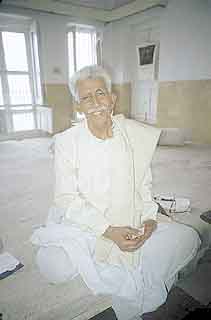 •
Holi Hey: A Festival of Love, Color, and Life, showing how the annual
north-Indian Spring festival of Holi is celebrated in the city of Banaras.
Mahant Veer Bhadra Mishra (photo to the right), spiritual
leader of the famous temple of Sankat Mochan Hanuman in the Holy City
of Banaras, recounts several explanations for the Holi festival. The
film dramatizes how once each year the Holi festival unites neighborhoods,
breaches the barriers of age, caste, social rank, and religious afiliations,
and calls on all to share in unity and merriment.
•
Holi Hey: A Festival of Love, Color, and Life, showing how the annual
north-Indian Spring festival of Holi is celebrated in the city of Banaras.
Mahant Veer Bhadra Mishra (photo to the right), spiritual
leader of the famous temple of Sankat Mochan Hanuman in the Holy City
of Banaras, recounts several explanations for the Holi festival. The
film dramatizes how once each year the Holi festival unites neighborhoods,
breaches the barriers of age, caste, social rank, and religious afiliations,
and calls on all to share in unity and merriment.
• Tulsidas and the Fire of the Veda,
from 1999, in which Mahant Veer Bhadra Mishra, explains the symbolism
of the performance of Yagya. He illuminates the threads of Indian tradition
which bind together the rituals of the Veda and the performances of Bhakti:
the Katha story-telling, the chanting of texts, Bhajan and Kirtan, and
the Lila dramas of the Avatar Ram and Krishna.
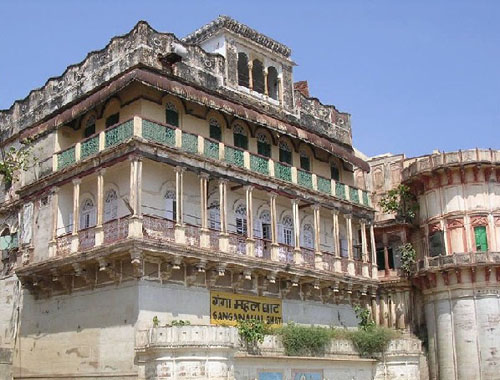 In 2004 Marc Katz completed a new film, ”Banaras
Muharram and the Coals of Karbala”, dealing with the
celebration of Muharram in Varanasi, the main festival of the Shia Muslims,
but in which also both Sunni Muslims and even Hindus take part. It narrates
the classical Muharram story and includes thoughtful interviews with Banarsi
Muslims, powerful scenes of Shi'ite worship (including self-wounding),
elaborate tazia processions, and scores of young men firewalking (fire-running)
through the ”coals of Karbala”. The film was released at the
33rd Annual Conference on South Asia held at the University of Wisconsin-Madison
15–17 October 2004. More
information on the film.
In 2004 Marc Katz completed a new film, ”Banaras
Muharram and the Coals of Karbala”, dealing with the
celebration of Muharram in Varanasi, the main festival of the Shia Muslims,
but in which also both Sunni Muslims and even Hindus take part. It narrates
the classical Muharram story and includes thoughtful interviews with Banarsi
Muslims, powerful scenes of Shi'ite worship (including self-wounding),
elaborate tazia processions, and scores of young men firewalking (fire-running)
through the ”coals of Karbala”. The film was released at the
33rd Annual Conference on South Asia held at the University of Wisconsin-Madison
15–17 October 2004. More
information on the film.
In February 2006 Dr. Katz received a SASNET
planning grant for a project
called ” The Vitality and Role of ‘Sporting
Clubs’ in the Multi-Cultural Community: A Study of the Traditional
Youth Organizations of Banaras” focusing on the organized
youth clubs prevalent in Varanasi, that often express respect and appreciation
for the multi-cultural (and multi-caste) flavour of the city. The ”organizing
committees” of the youth mandal, for instance, demonstrate a conscious
effort to maintain a multi-cultural presence in the committee and thereby
represent all the jati and cultural spheres of the neighbourhood (muhalla).
A study of the mechanisms working for both maintenance and erosion of
this longstanding system of organized youth groups is of interest to
both students of History of Religion and Peace and Conflict Resolution.
Major focus will be put upon
the activities of the Sarasvati Pujas of 2006 and 2007, but activities
of the youth groups throughout the year and organized around other rituals
will also be examined.
The research project is carried out in collaboration with Dr. Priyankar
Upadhyaya, Director & Professor of Peace Studies, Malaviya
Centre for Peace Research (MCPR), Faculty of Social Sciences, Banaras
Hindu University. PhD candidates at the MCPR
are trained and supervised by Katz and Upadhyaya and conduct the
field research in ten localities (muhallas) spread throughout the city
of Banaras. The project received a new SASNET grant in August 2006 for continued planning.
In November 2006 the Institute for
Interreligious Studies in Germany gave Dr. Marc Katz the 2006
INTR°A Project
Award. The award, 5,000 Euro, is designed for individuals, groups
or institutions that promote the complementation of the religions in
word and deed. Dr. Katz gets the award for for his research of ways of
religious life and his teaching on interreligious and interconfessional
encounter through the means of film. The motivation says that ”his
genuine, empathetic and instructive procedure is particularly convincing
represented in the films Banaras Muharram and the Coals of Karbala and Tulsidas
and the Fire of the Veda, developed and produced by Professor Katz
together with Staffan Winbergh”. The award was handed over
during the INTR°A conference, held 17–19 November
2006 in Iserlohn, Germany.
 |
| Prof. Veer Bhadra Mishra from Sankat Mochan Foundation hands over the prize to Dr. Marc Katz for his efforts to encourage the age-old cultural traditions of Varanasi in tune with current environmental needs on November, 4, 2007. |
• Together with the biologist Eeva
Lakomaa, Marc Katz is also engaged in the
Swatcha Ganga Project, which has been set up to clean the Ganges River.
They have collected funds and set up a laboratory for analysing the water
in the river. They plan for a website to present regular information about
the sanitary situation. MFS students have done fieldwork in this project.
Funds have come from Sida and from 'Svenska Naturskyddsföreningen'.
Prof.
Veer Bhadra Mishra, Profesor of Hydraulic Engineering at BHU, also founder of Sankat
Mochan Foundation (SMF), and Mahant of the Sankat Mochan temple in Varanasi, is a key person within this project. Prof Mishra has invited several Swedish researchers to come
to Varanasi as volunteers, and to use his lab facilities. More information on Prof. Mishra’s web page, http://www.sankatmochanfoundationonline.org/
On 4 November 2007, Dr. Marc Katz received an award for his “work for Ganga and promotion of the ideals of SMF”, at a ceremony in Varanasi, in connection with the jubilee of Sankat Mochan Foundation (see photo to the right).
The vision of the SMF foundation is to restore the Ganges by alleviating its fast deteriorating environmental conditions; to promote education and health care programs for the less privileged; and maintain and encourage the age-old cultural traditions of Varanasi in tune with the current environmental needs. Dr. Katz was also praised for his film works dealing with Varanasi. It was mentioned that "The Children of Assi" has recently been reprinted and released by Pilgrims Publishing
House, Varanasi (with a new index and color
photographs). ![]()
Dr. Katz participated in the SASNET workshop on ”The role of South Asia in the internationalisation of higher education in Sweden” held in Stockholm 28-29 November 2006, where he gave a presentation about Karlstad University Teachers training and other educational activities in Banaras and Dharamsala in the session about ”Sending students to South Asia”. He was also an invited speaker in the final panel discussion titled ”Best strategies for marketing Higher Swedish Education in South Asia, and for sending students to Higher Education in South Asia?” More information about the workshop.
C/D-level courses in History of Religion and Cultural/Human Geography
Every Autumn Karlstad University and Banaras
Hindu University offers 10–14 duly admitted students to the C/D-level
courses (20 credits) in History of Religions
and Cultural Geography at Karlstad University
(if meeting basic requirements for studies in India), the opportunity
to spend 10–15 weeks in Banaras (Varanasi). In India they study languages
(Hindi/Sanskrit), conduct individualized litterature and field studies
(related to their C/D thesis topics) under qualified supervision, and
participate in a joint BHU-Karlstad University seminar on the ”Multi-Cultural
Aspects of Banaras”, next time in the Fall 2008. More
information on the India Programme. ![]()
More information on Karlstad University´s
education connected to South Asia.
Read also Lars Eklund’s report from
the Swedish Study Centre at Varanasi in March 2002.
SASNET - Swedish South Asian Studies Network/Lund
University
Address: Scheelevägen 15 D, SE-223 70 Lund, Sweden
Phone: +46 46 222 73 40
Webmaster: Lars Eklund
Last updated
2008-03-06
